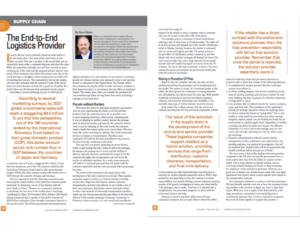This article was originally published by Loss Prevention Magazine and was written by ISCPO Board Member and past Chairman, Glenn Master.
If you’re like me, you’ve probably placed an order online in the last ninety days. Like most online experiences, it was likely seamless. You type a product in the search field, pull up comparable items, make a command decision, and place the order. When the experience concludes, you will have received an email confirmation of the order and the expected delivery date for your parcel. Most consumers who follow this process every day in the world don’t give a thought to what transportation providers will be handling their parcels. This responsibility falls on the retailer, who has been entrusted with the customer’s order. If the parcel shows up at the doorstep on time, life is good for all parties. If it doesn’t show up, life becomes bad, specifically for the retailer.
According to several marketing surveys, by 2021 global e-commerce sales will reach a staggering $4.5 trillion. To put that into perspective, out of the 190 countries ranked by the International Monetary Fund based on their gross domestic product (GDP), this dollar amount would rank number four in GDP between the countries of Japan and Germany.
China is expected to lead this blistering e-commerce pace, becoming the largest market on the planet for consumer goods purchased. As Americans, we are all too familiar with the
term “made in China.” However, as e-commerce continues to accelerate, the new term in the market place is becoming “purchased in China.” In November 2018, Alibaba CEO Daniel Zhang announced that it intends to help global business sell $200 billion in goods to China through e-commerce channels in the next five years. The Chinese government has hosted several logistics summits to try and promote its own internal e-commerce growth for Chinese retailers, who drastically want to sell and ship directly to consumers in the United States. The Chinese believe that consumers having the ability to order and receive products at their homes not only is a convenience but also offers an emotional impact. This makes sense when you consider the emotional lift you sometimes get when arriving home from work and seeing a package at your front door.
Parcels without Borders
 What does this mean for individual merchants and retailers who are now experiencing the ability to sell beyond their borders? First, the experience has to be as seamless as an in-store shopping experience, which can be a daunting task if you are shipping to another country. Second, the package must be delivered quickly, and typically the consumer doesn’t want to pay for shipping. In the same breath, the consumer wants a hassle-free returns policy at no cost to them. This now leaves the retailer searching for options. One of the most-costly services in business is transportation. Therefore, most companies will look for the most cost-effective way to move that box from the warehouse to the client. This cost will vary greatly depending on several factors, which would include the time it takes to deliver the package, the distance the package has to travel, and the method of delivery. Typically, the more convenient the process is for the customer, the higher the transportation cost will be for the retailer or individual merchant. As a result, most companies will look for a balanced approach that will satisfy both the customer expectation and the costs associated with transporting the order. The result of this evolution in the supply chain is the development of the end-to-end service provider. These logistics companies support retailers as a hybrid solution, providing services that range from distribution, customs clearance, transportation, and final-mile delivery. It can include a mix of their own proprietary distribution centers and trucks mixed in with a vast network of contracted transportation providers, which can also incorporate national post offices in the final-mile delivery. If this sounds confusing, it’s because it sometimes is. However, if done correctly it is a very sound and cost-effective method for the retailer to ship a customer order to someone who may be located on the other side of the planet.
What does this mean for individual merchants and retailers who are now experiencing the ability to sell beyond their borders? First, the experience has to be as seamless as an in-store shopping experience, which can be a daunting task if you are shipping to another country. Second, the package must be delivered quickly, and typically the consumer doesn’t want to pay for shipping. In the same breath, the consumer wants a hassle-free returns policy at no cost to them. This now leaves the retailer searching for options. One of the most-costly services in business is transportation. Therefore, most companies will look for the most cost-effective way to move that box from the warehouse to the client. This cost will vary greatly depending on several factors, which would include the time it takes to deliver the package, the distance the package has to travel, and the method of delivery. Typically, the more convenient the process is for the customer, the higher the transportation cost will be for the retailer or individual merchant. As a result, most companies will look for a balanced approach that will satisfy both the customer expectation and the costs associated with transporting the order. The result of this evolution in the supply chain is the development of the end-to-end service provider. These logistics companies support retailers as a hybrid solution, providing services that range from distribution, customs clearance, transportation, and final-mile delivery. It can include a mix of their own proprietary distribution centers and trucks mixed in with a vast network of contracted transportation providers, which can also incorporate national post offices in the final-mile delivery. If this sounds confusing, it’s because it sometimes is. However, if done correctly it is a very sound and cost-effective method for the retailer to ship a customer order to someone who may be located on the other side of the planet.
For example, picture a consumer in Seoul, South Korea, ordering a pair of shoes from a US-based retailer. The order will be picked, packed, and shipped out of the retailer’s distribution center in Atlanta, Georgia; however, the retailer is contracted with an end-to-end logistics provider. The parcel arrives at the provider’s US distribution center, is scanned in, and then placed with other retailers’ packages all destined for Seoul. The end-to-end provider then uses a large network of contracted partners that will handle that parcel as it moves from the US to Korea. The key to this type of solution is volume. The more volume the end-to-end provider can get from the retailer, the lower the cost is to the retailer. Having a Proactive LP Plan Based on this very complex network, one may ask how anything resembling loss prevention can be incorporated into this model. The answer is simple. As I mentioned earlier in this article, the shear growth of e-commerce is creating industries and subindustries that did not exist five years ago. With retailers worldwide continuing to look for cost-effective shipping solutions and customers demanding more flexibility, it was inevitable these type of hybrid solutions would be created. If the retailer has a direct contract with the end-to-end solutions provider, then the loss prevention responsibly will fall on that solution provider. Remember that once the parcel is received, the solution provider essentially owns it. With a high probability and depending on how the contract is worded, responsibilities may include labeling, customs clearance, tracking, security of the parcel, investigation of losses, and claim liability if the package is lost or stolen. Therefore, it is essential that a comprehensive loss prevention program is in place with the end-to-end solutions provider. However, it doesn’t stop there. What about all these contracted companies that are used? Here is where the rubber meets the road and where loss prevention must have a proactive plan in place that consists of the following elements:
■ A comprehensive security protocol that the contracted carriers must adhere to.
■ A robust auditing program that reviews compliance in the areas of security, scanning, and inventory control. As with most auditing, the basis is going to lie with the contractual verbiage that’s in place.
■ Loss analytics that can identify trends by country, company, route, and final mile. The foundation of this reporting is looking for package exceptions where the scanning stops, or what is commonly known as “going dark.” This is very similar to what retail loss prevention uses when running exception reports, except you are looking for trends for all touch points in a global supply chain. Regardless of whether a package circulates the globe and touches five different companies, if a scan is put to the package, and you can review that through reporting, you will see where losses are occurring.
■ Proactive communication with the carrier’s facility management, so they understand your expectations, loss trending analytics, and method of investigation. You will be surprised how receptive they will be to accept help and identify problems before they get out of hand. The one caveat is that unlike dealing with transportation companies in the US, there are specific government laws in each country that may limit the ability to conduct certain audits. This is more directed at specific actions, such as reviewing criminal background checks or drug screenings for employees versus operational processes. However, as a good rule of thumb, you should always check with your legal department and inquire about country-specific laws related to the transportation industry. As e-commerce continues to evolve, so will loss prevention. We have literally entered a new era in how the consumer shops and retailers must continue to figure out ways to ship these orders. What was once a supply chain dominated by a few large, proprietary companies is now expanding into a multifaceted approach that involves a myriad of companies that must all work together to support this growth.

Glenn is the Co-Founder and inaugural Chairman of the ISCPO. He currently is employed with Newgistics as the Sr. Director of Loss Prevention and as an Adjunct Professor at Texas Christian University. He has over 20 years of Loss Prevention experience both domestically and internationally with companies such as Motorola, Henry Schein and Office Depot. Glenn’s educational background includes a Master’s Degree in Criminal Justice from the University of Cincinnati and a Bachelor’s in Criminal Justice from the University of Texas-Arlington.


